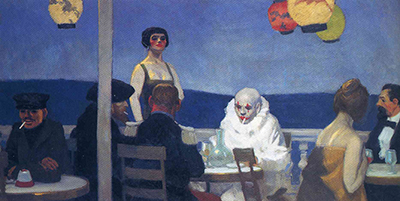Edward Hopper's Blue Night (Soir Bleu) in many ways stands out from many of his other works, yet in classic Edward Hopper style, it weaves a complex story with realistic characters that leaves the viewer to bring the story to life in their own imaginations.
Painted in 1914, Blue Night takes place in a Parisian café. While Hopper is generally associated with scenes of Americana, this earlier piece takes us into a time when Hopper was studying in Paris, his famed career of depicting lonely, waiting figures in the American sunlight still somewhere in his future.
The scene in Blue Night is a colourful one. Immediately, the eye is drawn to the white-clad clown seated at the table. He seems painfully out of place in this scene among the other diners.
The couple on the right, the man dressed in his fine tuxedo and the lady in her evening gown appear to be quite posh, and visibly irritated at the this cigarette-smoking clown seated next to them.
Across from him are two other interesting characters: a military officer in full uniform and bearded man dressed in black, sporting a black beret, possibly an artist or other sort of intellectual. The woman standing behind the scene in the garish make-up looks down her nose at the clown, her expression and posture haughty.
On the left of this scene, a lone man sits, apparently oblivious to the scene taking place.
Blue Night serves to communicate the strong impressions that Parisian life made on Edward Hopper, but perhaps this scene and its traditional characters, like other Edward Hopper paintings, is telling a richer, more emotional story. Each member of this cast of characters symbolizes a different tier of Parisian society; each one of them so unlike the other.
The mood is one of loneliness, and the scene perfectly captures the feelings of alienation when immersed in a foreign culture. Being a stranger in a strange land, one often feels that they stand out uncomfortably in the crowd, like a sore thumb, or a glowing, sad clown among the bourgeoisie in a café. But, as is the way with a Hopper painting, the details of the story are left to the viewer's imagination.




